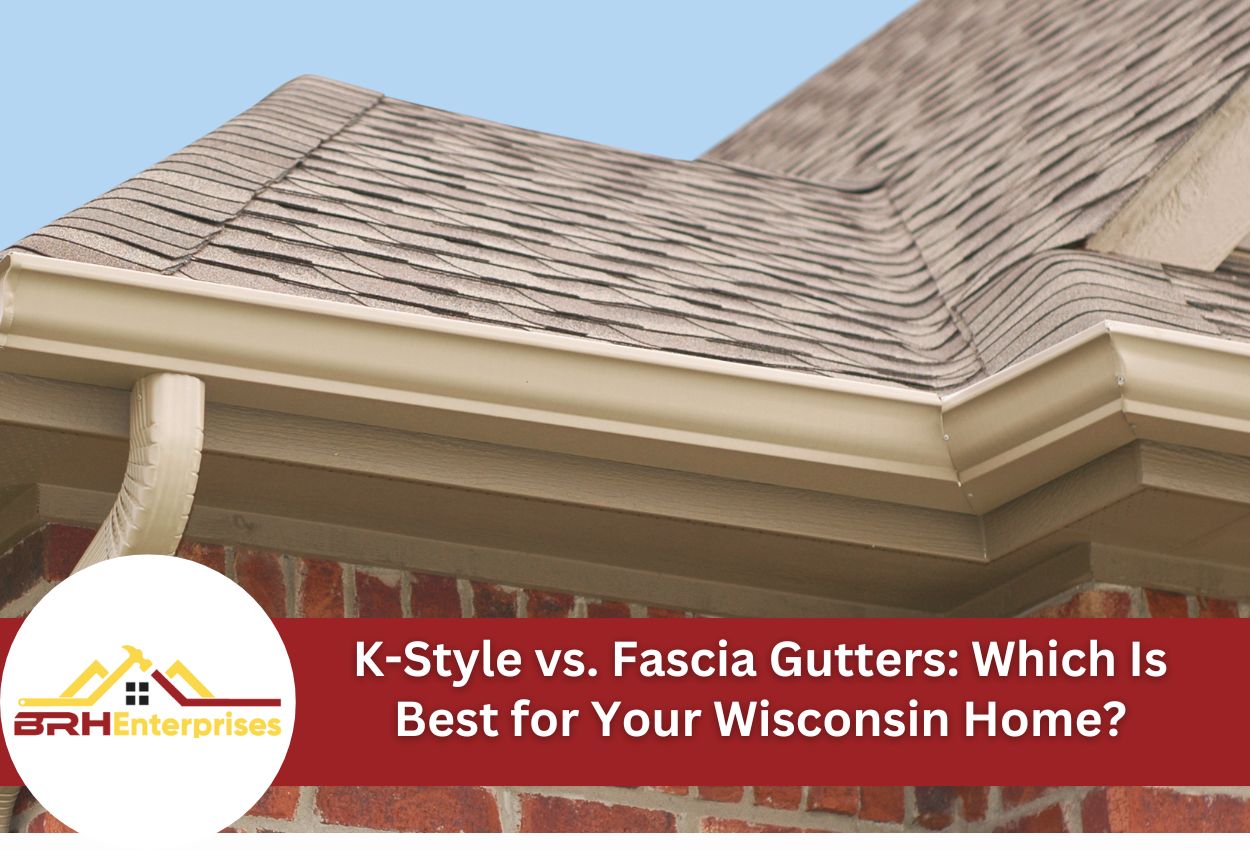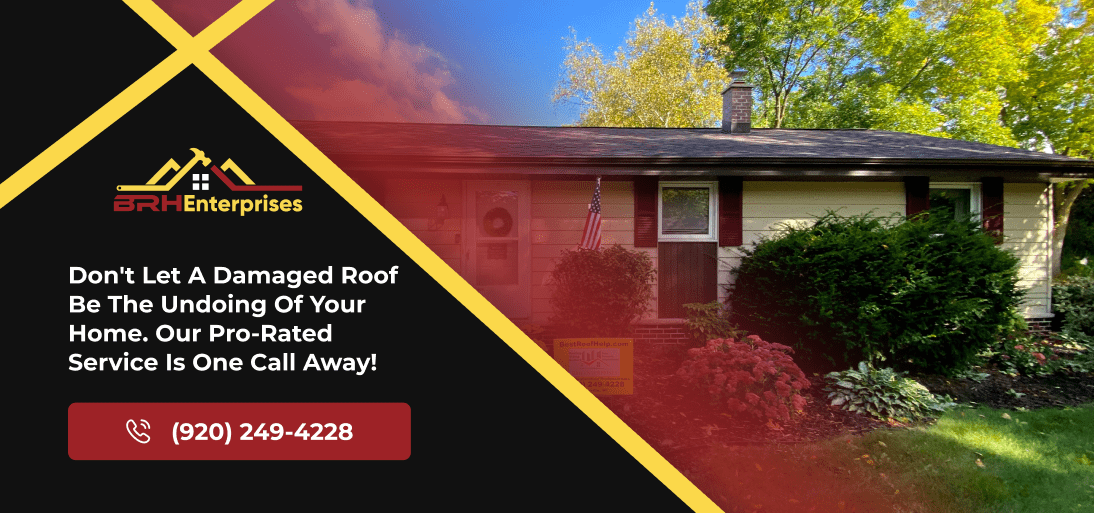K-Style vs. Fascia Gutters: Which Is Best for Your Wisconsin Home?
Estimated Reading Time : 6 Min.

For Wisconsin homeowners, selecting the right gutter system isn’t just about looks, it’s an important decision that impacts your home’s structural integrity. With Wisconsin’s heavy spring rains, summer storms, and winter snow melt, properly functioning gutters are essential for getting water away from your home’s foundation, which prevents erosion, basement flooding, and damage to your home overall.
K-style and fascia gutters represent two approaches to water management for residential properties. While both serve the same fundamental purpose, they differ significantly in design, installation methods, and visual impact on your home’s exterior. K-style gutters, with their decorative crown molding-like appearance, remain the most common choice across Southern Wisconsin neighborhoods. Fascia gutters, alternatively, offer a sleek, seamless look that integrates directly with the roofline.
The distinction between these gutter systems is more than just the appearance. Each type has its own advantages regarding water capacity, durability, maintenance requirements, and compatibility with different architectural styles. Wisconsin’s climate calls for gutters that can handle a lot of water at once while withstanding seasonal temperature changes, making this decision particularly important for local homeowners.
Understanding the key differences between K-style and fascia gutter systems helps ensure your home remains protected against moisture damage while complementing its overall design. This comparison examines the practical and visual considerations that help with your gutter selection.
Understanding Gutter Basics: K-Style vs. Fascia Fundamentals
When it comes to protecting Wisconsin homes from water damage, understanding the fundamental differences between gutter styles is essential. K-style gutters, named for their profile that resembles the letter K when viewed from the side, feature a flat back and bottom with a front that looks like crown molding. These gutters have become the standard across Southern Wisconsin due to their higher water capacity and traditional visual appeal. Made from aluminum, copper, or vinyl, K-style gutters attach to the fascia board and are available in different widths, though the most commonly used are 5-inch and 6-inch widths.
Fascia gutters integrate directly with the fascia board of your roof. These gutters are custom-built to fit seamlessly against your home, creating a clean appearance. Unlike K-style gutters that hang from the roof’s edge on brackets, fascia gutters are flush with the fascia board. This integrated design eliminates the gap between the gutter and fascia board, giving better protection against any water that could slip behind the gutter system.
Water Management Capabilities: Performance in Wisconsin Weather
Wisconsin’s climate has unique challenges for gutter systems. From spring downpours to winter freeze-thaw cycles, gutters handle a lot of water year-round. K-style gutters excel in water capacity, typically carrying up to 1.2 gallons per foot (on 5-inch gutters) compared to similar-sized alternatives. This higher capacity makes them particularly effective during intense summer thunderstorms common across Southern Wisconsin, where rainfall can exceed 2 inches per hour.
Fascia gutters have different advantages in Wisconsin’s challenging weather. Their seamless, integrated design eliminates joints where leaks commonly develop, performing well during prolonged rain. Their seamless construction also helps prevent ice dam formation during winter freeze-thaw cycles. The tight connection between fascia gutters and the roofline reduces the chance of water infiltration, helping protect fascia boards from rot in our moisture-heavy climate.
When comparing gutter performance in extreme weather, K-style gutters handle heavy volume efficiently but may require more maintenance at connection points. Fascia gutters require less maintenance, but initial installation costs tend to be higher. For Wisconsin homeowners concerned about ice buildup, fascia gutters with properly installed heating elements (when available) provide excellent protection against winter damage.
Aesthetic Considerations: How Each Gutter Style Affects Your Home’s Look
The visual impact of your gutter system significantly influences your home’s curb appeal. K-style gutters have become a staple in Wisconsin neighborhoods partly because of their versatility across architectural styles. Their decorative front edge mimics crown molding, making them particularly complementary to traditional home styles common in Madison and Colonial revival styles found throughout Southern Wisconsin’s historic neighborhoods. The defined lines of K-style gutters add visual interest, creating breaks along rooflines that enhance a home’s proportions.
Fascia gutters offer a different look, creating a clean, unobtrusive look that blends with the roofline. This streamlined appearance makes them ideal for contemporary and mid-century modern homes throughout the region. The seamless integration particularly enhances Prairie-style architecture, a Wisconsin favorite, where horizontal lines and minimal ornamentation are defining characteristics. In newer subdivisions across Dane County and surrounding areas, fascia gutters provide the polished, cohesive exterior many homeowners seek.
To fit your home’s trim color, customizable color options are available but, if you’re looking to have them stand out, you could choose a contrasting color. When assessing which style better suits your home, consider your property’s existing architectural elements. Homes with detailed trim work and traditional styling often benefit from K-style gutters, while properties with cleaner lines and minimalist design generally look more cohesive with fascia gutters. The right choice will balance looking good and being functional for your home’s needs.
Installation and Maintenance Factors to Consider
The installation process is different between these two gutter systems. K-style gutters typically require less specialized labor, which makes them more accessible for Wisconsin homeowners. They’re installed using brackets or hangers attached to the fascia board, and pre-fabricated sections are joined together on-site. While some experienced DIYers might tackle K-style installation, the process still involves precise measurements and figuring out the proper slope to make sure the water flows away from your home’s foundation.
Fascia gutters need professional installation due to their custom-built nature. These systems are typically made on-site using specialized equipment that forms seamless gutters matched exactly to your home’s dimensions. This installation blends directly with your roofline, needing coordination with other parts of your roof. For most Southern Wisconsin homes, fascia gutter installation is exclusively a professional service due to the specialized equipment and expertise required.
Wisconsin’s freeze-thaw cycles create unique maintenance challenges for both systems. Ice dams can affect any gutter type, but proper installation with adequate insulation and ventilation helps minimize these issues regardless of which style you choose.
Durability and Longevity: Making a Lasting Investment
When it comes to withstanding Wisconsin’s challenging climate, not all gutters perform equally. K-style gutters typically have excellent structural integrity due to their bent design, which creates inherent rigidity. This added strength helps them withstand the weight of heavy ice accumulation during the winter. However, their sectional nature creates weak points at seams and joints, areas particularly vulnerable during Wisconsin’s freeze-thaw cycles, when water expands and contracts repeatedly.
Fascia gutters offer superior durability through their seamless construction. With fewer connection points, these systems eliminate many common failure points found in traditional gutters. The direct integration with the fascia board provides additional structural support, helping prevent the pulling away that often occurs with hanging gutter systems after years of snow and ice. This structural advantage becomes particularly valuable in Southern Wisconsin’s lake-effect snow regions, where winter precipitation can be very high.
Material selection dramatically impacts longevity regardless of gutter style. Aluminum remains popular for both systems due to its rust resistance and moderate cost, typically lasting 20 or more years with proper maintenance. Copper gutters, though significantly more expensive, can last 50 or more years and develop a distinctive look that enhances certain architectural styles. Steel options provide exceptional strength but require proper coating to prevent rust in Wisconsin’s humid summers. For homes in heavily wooded areas like those common in Southern Wisconsin, consider gutter guards when selecting materials. This additional piece can extend the lifespan of your gutters by blocking large debris from getting in, causing backups and poor drainage.
Making Your Decision: Factors That Should Influence Your Gutter Selection
Selecting between K-style and fascia gutters comes down to several factors surrounding your home. First, consider your home’s architectural style. Traditional homes with decorative aspects typically pair well with K-style gutters, while contemporary homes with clean lines often benefit from fascia gutters’ streamlined appearance. Southern Wisconsin’s varied housing designs, from historic Madison neighborhoods to newer suburban developments, accommodate both styles effectively.
Your specific local climate matters significantly as well. Properties in heavily wooded areas might benefit from fascia gutters’ reduced debris collection, while homes in open areas subject to heavy downpours might need K-style’s greater water capacity. Consider your property’s specific drainage needs, including roof size, pitch, and existing water management challenges.
Budget considerations play a role in your decision as well. While K-style gutters generally offer lower initial installation costs, fascia gutters may provide better long-term value through reduced maintenance requirements and extended lifespan. Think about your plans for the property, too. A forever home might justify the higher investment in fascia gutters, while a shorter-term residence might make K-style more practical.
For personalized guidance, consulting with a reputable Southern Wisconsin roofing contractor provides valuable insights. Local professionals understand regional weather, building codes, and installation best practices for our area. They can evaluate your specific home and recommend the gutter system that offers the best balance of performance, looks, and value for your particular situation.
Discover the Best Gutter Solution with BRH Enterprises LLC
Choosing the right gutters for your Wisconsin home is not just about managing water; it’s about enhancing your home’s look and ensuring long-term protection against the elements. Whether you’re leaning towards the classic charm of K-style gutters or the seamless integration of fascia gutters, BRH Enterprises LLC is here to guide you through every step. Our expertise in local weather conditions and home styles ensures that your gutter installation will be perfectly suited to your needs.
Don’t let another rainy season compromise your home’s structural integrity. Call us today at (920) 249-4228 to discuss your options and find the best gutter solution that stands the test of time and weather.


